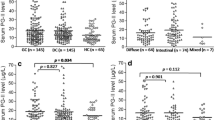Abstract
There are some reports the gastric atrophy induces the downregulation of PG I and, contrariwise, that H. pylori (Hp) infection induces PG I. The aim of this study is to clarify this discrepancy and the relationship between Hp infection and PG I&II. Biopsy specimens and sera were obtained from 207 patients with dyspeptic symptoms undergoing diagnostic endoscopy for Hp infection, atrophic pattern, and estimation of anti-Hp antibodies (Ab) and PG I&II. PG I&II levels were compared before and after eradication in both successful and unsuccessful cases in 53 peptic ulcer patients. In all, 164 cases were Hp positive and 27 cases were Hp negative. For atrophic pattern, the 27 Hp-negative patients were classified into the C1 (N = 26) and C2 patterns (N = 1), and the 164 Hp positive patients were classified into C1 (N = 27), C2 (N = 34), C3 (N = 28), O1 (N = 41), O2 (N = 22), and O3 patterns (N = 12). PG I&II decreased according to the atrophic grade among Hp-positive patients. There are substantial associations between Hp status and PG I&II levels in the C1 pattern, and PG I&II levels are statistically lower in successful cases after eradication. In conclusion, Up-regulation of PG I&II is strongly associated with Hp infection and may lead to ulcer formation.
Similar content being viewed by others
REFERENCES
Marshall BJ, Warren JR: Unidentified curved bacilli in the stomach of patients with gastritis and peptic ulceration. Lancet 1:1311–1315, 1984
Blaser MJ: Helicobacter pylori and the pathogenesis of gastroduodenal inflammation. J Infect Dis 161:626–633, 1990
Kouchiyama T, Tada M, Shigeeda M, Karita M, Yanai H, Kawano H, Murakami A, Okazaki Y, Takemoto T, Konishi H, Nakazawa T: Significance of Campylobacter pylori in chronic castritis. In Campylobacter pylori and Gastroduodenal Diseases, (Vol. 1). T Takemoto, K Kawai, T Shimoyama (eds). Tokyo, Organizing Committee of Tokyo International Symposium on Campylobacter pylori, 1989, pp 184–194
Kimura K: Chronological transition of the fundic—pyloric border determined by stepwise biopsy of the lesser and greater curvatures of the stomach. Gastroenterology 63:584–592, 1972
Varis K, Isokoski M: Screening of type A gastritis. Ann Clin Res 13:133–138, 1981
Correa P: Chronic gastritis. In Gastrointestinal and Oesophageal Pathology. R Whitehead (ed). Edinburgh, Churchhill Livingstone, 1989, pp 405–406
Samloff IM: Cellular localization og group I pepsinogens in human gastric mucosa by immunofluorenscence. Gastroeterology 65:185–188, 1971
Oderda G, Vaira D, Holton J, Dowsett JF, Ansaldi N: Serum pepsinogen I and IgG antibody to Campylobacter pylori in non-specific abdominal pain in childhood. Gut 30:912–916, 1989
Asaka M, Kimura T, Kudo M, Takeda H, Mitani S, Miyazaki T, Miki K, Graham D: Relationship of Helicobacter pylori to serum pepsinogens in an asymptomatic Japanese population. Gastroenterology 102:760–766, 1992
Samloff IM, Liebman WM: Cellular localization of group II pepsinogens in human stomach and duodenum by immunofluorenscence. Gastroeterology 65:36–42, 1973.
Oderda G, Vaira D, Holton J, Ainley C, Altare F, Ansaldi N: Amoxicillin plus tinidazole for Campylobacter pylori gastritis in children: assessment by serum IgG antibody, pepsinogen I, and gastrin levels. Lancet 1:690–692, 1989
Karita M., Matsumoto S: Why did the infiltration of the lymphocyte occur in Helicobacter pylori negative case by culture? Jpn J Gastroenterol 96:450, 1999 (in Japanese)
Karita M, Tummuru MKR, Wirth HP, and Blaser MJ: Effect of growth phase and acid shock on Helicobacter pylori cagA expression. Infect Immun 64;4501–4507, 1996
Atherton JC, Peek RM, Tham KT, Cover TL, Blaser MJ: Clinical and pathological importance of heterogeneity in vacA, the vacuolationg cytotoxin gene of Helicobacter pylori. Gastroenterology 112:92–99, 1997
Huang SC, Miki K, Furihata C: Enzyme-linked immunosorbent assay of serum pepsinogen I and II using monoclonal antibodies—with data on peptic ulcer and gastric cancer. Clin Chim Acta 175:37–50, 1988
Karita M, Matsumoto S: Subgrouping of Helicobacter pylori strains into Japanese and USA type by PCR based on each cagA. In The 3rd Annual Meeting of the Japanese Research Society for Helicobacter pylori Related Gastroduodenal Diseases. T Takemoto, K Kimura, T Shimoyama, T Fujioka (eds). Tokyo, The Japanese Research Society for Helicobacter pylori-Related Gastroduodenal Diseases, 1997, p 76
Kuipers EJ, Uyterlinde AM, Pena AS, Roosendaal R, Pals G, Nelis GF, Festen HPM, Meuwissen SGM: Long-term sequelae of Helicobacter pylori gastritis. Lancet 345:1525–1528, 1995
Rights and permissions
About this article
Cite this article
Karita, M., Noriyasu, A., Kosako, E. et al. Relationship Between Pepsinogen I&II and H. pylori Infection Considered with Grade of Atrophy and Gastroduodenal Diseases. Dig Dis Sci 48, 1839–1845 (2003). https://doi.org/10.1023/A:1025423902479
Issue Date:
DOI: https://doi.org/10.1023/A:1025423902479




